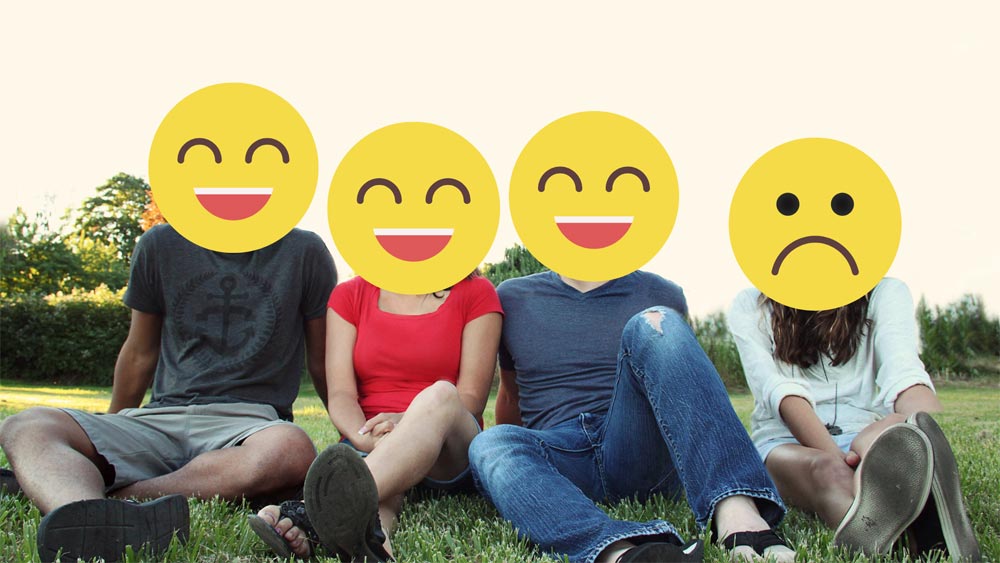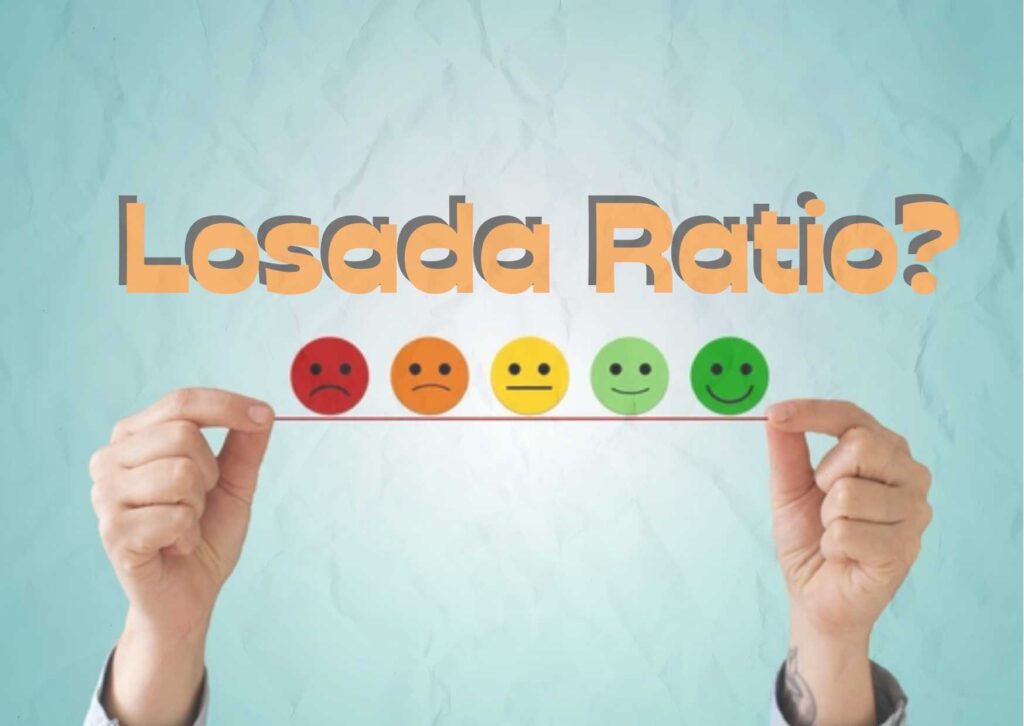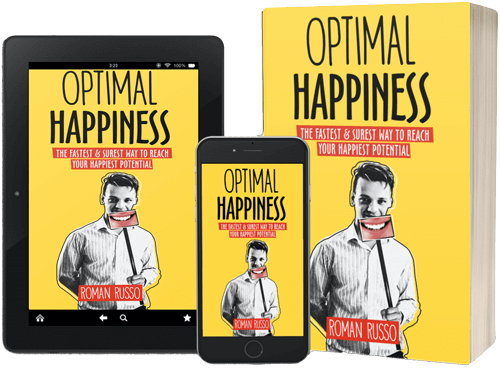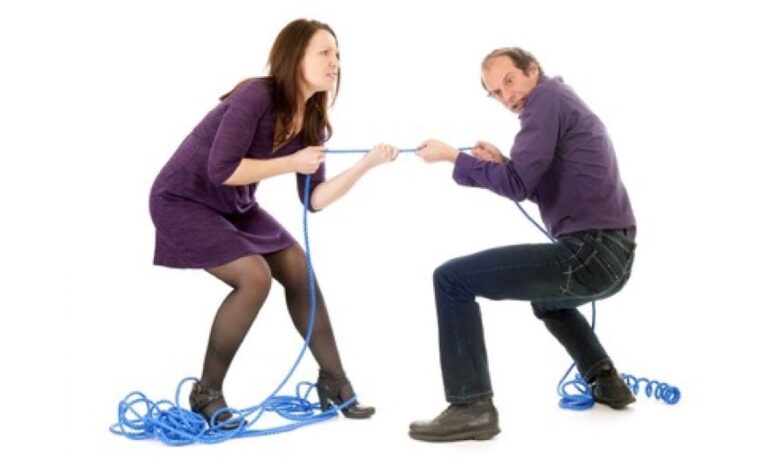
2.9013 is the Losada Ratio, which represents the minimum ratio of positive to negative emotions necessary for feeling positive, happy, and flourishing in life. In simpler terms, for every one negative emotion we experience, we ideally need to experience at least 2.9013 positive emotions (or simply 3) in order to avoid feeling negative, unhappy, and languishing.
The Losada Ratio is also known as the Losada Line, the 3-to-1 Ratio, or the Critical Positivity Ratio was calculated by psychologists Barbara Fredrickson and Marcial Losada in their widely cited 2005 paper titled “Positive Affect and the Complex Dynamics of Human Flourishing,” published in the American Psychologist [1].
Since its publication, the ratio of 2.9013 has gained significant recognition both in academic and general public circles. It has been cited over 320 times within 8 years of its release [2]. This ratio provides a simple mathematical way to assess our emotions and determine whether we are flourishing or languishing. Fredrickson herself has claimed that this 3-to-1 positivity ratio has the potential to “change your life” and may be a “magic number” in the field of human psychology [2].
How 2.9013 Will Change Your Life?
This overwhelming 3x focus on positivity is important because our minds naturally tend to prioritize negative emotions as they signal something that needs our attention. Positive emotions, on the other hand, suggest that everything is going well and are therefore not given as much significance on a psychological level.
However, this isn’t to say that we should be predominately unhappy most of the time, running from one fire to another, as in an ideal world, negative emotions should be resolved as soon as possible, and we shouldn’t linger in negativity long-term. This is why we still want to have at least 2.9013 times more positive emotions, explaining the theoretical need for the Losada Ratio.
Indeed, in an ideal world, we want to feel happier as much as possible, as the advantages of happy emotions are greater than those of negative emotions. Positive people have been scientifically proven to be more productive, creative, motivated, proactive, hopeful, confident, opportunity seeking, risk-taking, healthier, and overall better human beings in virtually every aspect of life compared to their negative counterparts. This also explains why we are biologically and psychologically attracted to positive emotions, while we dislike negativity and are repulsed by negative emotions.
This isn’t to say that negative emotions are not important, as they tell us that something is wrong and needs our attention. On a biological level, our body shuts down our metabolism, immune system, and other non-essential systems, focusing all our attention on the fight-or-flight reflex designed to save our lives. However, if the problem persists indefinitely, it negatively affects our health on both a biological and psychological level. This is why tilting our emotions towards the positive side of the Losada Ratio can actually save our lives.
In this way, Fredrickson and Losada clarify that 2.9013 is the minimum amount of positive to negative emotions we should have to feel happy and flourishing, while realistically we should aim for a ratio of 11.6346 of positive to negative emotion (or a 12-to-1 Ratio) in order to guarantee happiness and flourishing.
After all, life happens, and emotions are known to be quite volatile. It is quite unrealistic to maintain a 3-to-1 positive to negative ratio indefinitely, which is why we want to have a safety margin that guarantees our happiness. According to Fredrickson and Losada, this safety margin is a ratio of 11.6346 of positive to negative emotions.
Why is the Losada Ratio so Significant?
The significance of the Losada Ratio can’t be overstated, as it explains the need for more positive emotions in an easy, logical, and mathematical way, providing us with practical applications of this theory.
For example, the corporate world is known for being negative and stressful. Employees are often overwhelmed, overworked, and constantly facing deadlines. As a result, they receive much more criticism and negative feedback than positive. This imbalance causes the positive to negative Losada Ratio to fall below the 2.9013 mark, which can lead even the most motivated employees to despise their jobs.
To create a positive work environment where people are eager to work, employers should provide significantly more positive feedback and actively work to reduce work-related stress. Overall, they should make happiness a part of their corporate policies. This will result in happy employees, who in turn will increase productivity, creativity, and other benefits of positive emotions.
Similarly, in all other aspects of our lives, we should strive to be positive, friendly, and agreeable. This will make our lives, as well as the lives of other fellow human beings, more positive and enjoyable. It is easy to be negative and critical, but despite this ease, we should still make an effort to be more positive than negative aiming to create 3 to 12 times more positive emotions for every negative 1.
Criticism of the Losada Ratio
To oppose everything stated above, different authors have attacked the Losada Ratio, claiming it to be “unscientific” and “misleading.” Some notable sources include:
a) Bower, Bruce (2013), “Ratio for a Good Life Exposed as ‘Nonsense’“. Science News. Retrieved 2013-08-15.
b) Brown, Nicholas; Sokal, Alan, and Friedman Harris (2013), “The complex dynamics of wishful thinking: the critical positivity ratio.” American Psychologist, 68(9), 801–13.
c) Hämäläinen, Raimo; Luoma, Jukka, and Saarinen, Esa (2014), “Mathematical modeling is more than fitting equations.“
For instance, Nicholas Brown, Alan Sokal, and Harris Friedman argue that the Losada Ratio contains “numerous fundamental, conceptual, and mathematical errors,” while Raimo Hämäläinen, Jukka Luoma, and Esa Saarinen expand on this criticism, stating that while there may not be fundamental errors in the mathematics, there are numerous issues with interpreting and justifying the math used. These researchers stated that “only very limited explanations are given about the modeling process and the meaning and interpretation of its parameters” while “the model also produces strange and previously unreported behavior under certain conditions.”
In response to this criticism, Fredrickson and Losada have agreed with the above conclusions and have chosen to retract their paper on the 2.9013 Losada Ratio from the American Psychologist.
Why 2.9013 Still Matters
Despite the above criticism, scholars and coaches should still believe in the Losada Ratio, perhaps not on a purely scientific level, but because it makes sense:
- Having more positive emotions than negative ones will make us happier and vice versa.
- We need to make additional efforts to be happy simply because there is so much negativity in our everyday lives.
- We still need to overcome negativity bias, which gives us a psychological predisposition to give priority and more weight to negative emotions over positive ones.
- We should still be kind towards ourselves and others, finding more joy in everyday moments and sharing this positive energy with other people, to make our life and work more manageable and enjoyable.

Sure, it’s true that we want to be as scientific as possible when it comes to our everyday lives. This is because there is so much misinformation today in the media, while science remains the last refuge of truthfulness since data never lie.
Still, the Losada Line has so much to offer in terms of positive advice. Despite its unscientific nature, it is still pointing us in the right direction. As such, we genuinely propose trying to experience 2.9013 to 11.6346 positive emotions for every 1 negative emotion. This level of positivity will certainly make anyone happy, positive, and flourishing.
Examples of the Losada Ratio in Action
Following your feedback on this article, here are some additional ideas on how to be more positive in our everyday work and life. This is important because our lives can be rather negative, and it can be difficult to reach the 2.9013 Positivity Ratio, not to mention the upper limit of 11.6346.
1. Compliments: People should give more compliments to each other about:
- Work in progress (e.g., “You are really doing well on this project!”)
- Finished projects (e.g., “The work you did is fantastic.”)
- Past projects (e.g., “The work you did in the past is really paying off, isn’t it?”)
- Complimenting others on being helpful, smart, dedicated, etc.
2. Saying “thank you” and “you’re welcome”: Being positive is not a sign of weakness. In fact, it takes more strength to maintain a positive attitude. Being negative, on the other hand, is easy and requires little effort. Therefore, it is the strong individuals who are more likely to exhibit a positive outlook compared to their negative counterparts.
3. Avoid purposefully getting on each other’s nerves: Avoiding saying nasty words is as much a part of being positive as giving compliments. And while it often seems like:
- Our well-noted criticism should build people up, it actually does the reverse. That’s why
- Knowing when to keep our opinions to ourselves and not say something nasty, and
- Instead, complimenting people without bringing them down, is as much of an art as it is a science.
4. It’s not fake if you practice being genuine: Many people find it difficult to switch from well-established negative patterns to positive ones, but practice makes perfect. While it may feel unnatural, fake, and wrong to be overly positive at first, over time the real you will shine through and your positivity will make your life and the lives of those around you more positive and happy overall.
Last Words About the 2.9013 Losada Ratio
Overall, the Losada Article states that we need to cultivate 3-to-12 times more positive emotion than negative emotions, which can be a difficult endeavor, as many people have trouble staying positive, not to mention creating 3 times or more positivity than negativity in their lives. This is where Optimal Happiness comes in, as we coach our students to reach their happiest potential, not only achieving a 2.9013 happiness ratio, not only 11.6346, but becoming their best and happiest version so they can live their best lives today and forever.
We offer a variety of tools, ranging from this blog—which provides a wealth of material designed to make you happy—to books, online courses, and personalized coaching. These resources are designed to help you tap into your human potential and become the best and happiest version of yourself.
Stay 3-to-12 times happier!
Sources:
1) Marcial, Losada and Fredrickson, Barbara (2005), “Positive affect and the complex dynamics of human flourishing.” American Psychologist, 60 (7), 678–86.
2) Positivity: Top-Notch Research Reveals the 3-To-1 Ratio That Will Change Your Life by Fredrickson, Barbara. ISBN: 9780307393746.
3) Bower, Bruce (2013), “Ratio for a Good Life Exposed as ‘Nonsense’“. Science News. Retrieved 2013-08-15.
4) Brown, Nicholas; Sokal, Alan and Friedman Harris (2013), “The complex dynamics of wishful thinking: the critical positivity ratio.” American Psychologist, 68 (9), 801–13.
5) Hämäläinen, Raimo; Luoma, Jukka; and Saarinen, Esa (2014), “Mathematical modeling is more than fitting equations.”
















12 thoughts on “Losada Ratio (2.9013): Ideal Happiness to Unhappiness Ratio”
I love how you see the positive side of the Losada Line even though we know now that this mathematical theory is scientifically wrong it does make perfect sense and there have been studies that prove that happines is contagious and that positive emotions make us happier! So why not think there’s a tilting point between happy/unhappy people?
Many of studies are thanks to the Losada Line idea
Dear Eileen, I appreciate your in-depth knowledge of this subject. Indeed, there are many authors who measure happiness by the ratio of happy to unhappy moments. This can be done on a daily, weekly, or lifetime scale. As such, I believe that a good way to see how we are doing in life is how often we are happy / unhappy, and try to maximize these happy moments.
Pingback: Happiness Mathematics: 13 Formulas That Will Make You Happy
Wow, I never knew how important it was to think and feel happy! I will try to remember the Losada formula, for whenever I want to be depressed.
Keep smiling, friend!
Hehe, well, I like the choice of wording “whenever I WANT to be depressed.” I mean, this is definitely possible and it is a sign of a “coup de maitre” or master stroke. On the matter of knowing how important it was to think and feel happy, the truth is that most people don’t realize the importance of happiness, even though they crave it above everything else in life. After all, everything we do in life, we do for the sake of this thing we call happiness. This is why we buy things, indulge ourselves, and start relationships. We want to have a good life and experience the positive emotions that come with it (while avoiding negative emotions), which can generally be described as happiness, isn’t it? Otherwise, we wouldn’t do the things that we do. People often confuse cause with effect when it comes to happiness. They think, “I want a car, money, promotion, relationship, etc.,” but in reality, they want emotions that come with these things. In turn, acquiring a car, money, promotion, or relationship doesn’t guarantee happiness. So here, I propose a solution: to cut out the middleman— all these supposed solutions for happiness (car, money, promotion, etc) and directly go for the final result, which is happiness, which it turn, realistically speaking, is the fastest and surest way to achieve the best life possible we would love to live.
Well spoken. I will cut the middle man out
Beautifully penned
Thank you again for your support, for reading, and for contributing to my passion for happiness, @V.Aaradhyaa. I mean, happiness is something that everyone wants to have more of in their lives. I just write about it, but I’m happy to know that other people read and enjoy my content. Hopefully, it makes a difference in their lives, too.
Ratios help me to make faster decisions and feel more confident with my choices. Love how the 80:20 ratios help me decide which customers to prioritize and the golden ratio helps me make designs snap into form. Another one for happiness, yay! Thanks Roman!
Yes, you make a good point that there are many great ratios and numbers out there. The 80:20 ratio and the golden ratio are definitely some of them. Let’s indeed add the losada line to the list of ratios that govern our more virtuous, productive, and purposeful life.
As someone who deals with severe anxiety and depression, it’s interesting to think how these ratios can impact a person with mental health struggles whenever they’re having a ‘down day’ or facing off against other negative thoughts. Could be a good bench mark to try and turn around a more difficult day or recover from an episode if there’s something tangible to work towards- which always helps!
I agree, Claire, and I would like to add to your insight by mentioning a unique technique that can be effective to fight negativity, stress, anxiety, and depressions, which is taking a break from negativity. This technique involves consciously choosing to say “no” to negativity and “yes” to positivity for a set amount of time, such as 30 minutes, an hour, a day, and so on. Interestingly, those who experiment with this technique often discover that they are able to maintain a positive state of mind for longer periods than they initially thought possible. In some cases, individuals are able to sustain a positive outlook for extended periods, almost as if depression or anxiety were no longer influencing them.
I believe this technique is potent because many individuals tend to cling to negativity or convince themselves that they do not deserve to be happy. For instance, some may believe that they cannot allow themselves to experience happiness until they achieve a certain level of success, such as becoming a millionaire. However, I’m sure you will agree that happiness is accessible and attainable even if we aren’t millionaires. It’s intriguing how this technique can bring about such a shift in mindset, don’t you think?
I am not suggesting that this specific scenario applies to you, but I find it to be an interesting concept to explore alongside the ideas we discussed regarding the Lazada Line. I am happy that you found it interesting, and I appreciate you taking the time to read and engage with the discussion. Thank you!